#Dabous Giraffes
Text

The largest animal rock petroglyphs in the world; known as 'Dabous Giraffes', located in Air Massif, Niger. The carvings are believed to have been done between 12000-7000 BC, during African Humid Period (14600-5000 years ago), when this region was less arid, and Sahara was a vast savannah, that streched thousands of miles. There are also remains of petrified wood found in the area, which gave evidence that region could sustain animal and human life.

#kemetic dreams#africa#dabous giraffes#niger#air massif#african humid period#shara#sahara#animals#animals in art#animal art
9 notes
·
View notes
Text
On the blog for #WorldGiraffeDay: The Dabous Giraffes
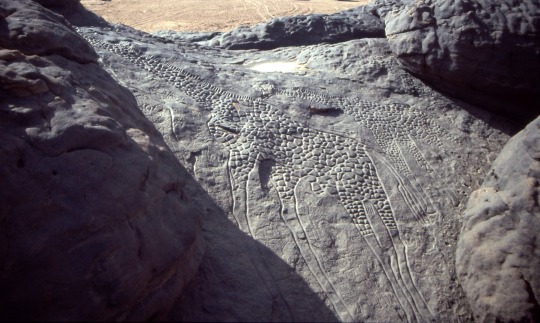
The Dabous Giraffes (on-site photo)
These two life-size giraffe petroglyphs are the largest known animal carvings in the world! They are found in Africa the Aïr Massif region of the Sahara Desert in modern-day Niger, and have been dated to the Neolithic c. 6000-8000 BCE., during the lusher African Humid Period. More info here:
#Dabous Giraffes#African art#rock art#petroglyph#Neolithic art#African Humid Period#ancient art#prehistoric art#giraffe#giraffes#World Giraffe Day#animal holiday#blog post
0 notes
Photo
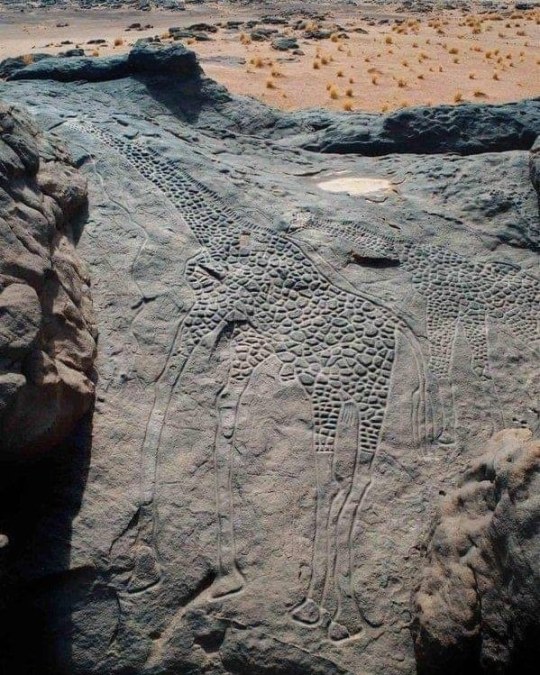
Dabous Giraffes, dated 8000 BC, Dabous, Aïr Mountains, Niger,
Two of the biggest animal rock Neolithic petroglyphs in the world!
The carvings are 6 metres (20 ft) in height and consist of two giraffes carved into the Dabous Rock with a great amount of detail. One of the giraffes is male, while the other, smaller, is female.
Credit: historydefined
#art#design#animals#dabous#giraffe#niger#africa#petroglyphs#neolithic#air mountains#rock#carved#style#history
1K notes
·
View notes
Text
The Magnificent Dabous Giraffes: An Ancient Testimony in Niger's Desert
The Dabous Giraffes stand as a testament to the ancient artists who carved their majestic forms into the rugged surface of the Dabous Rock. Situated on the western side of the Aïr Mountains in the expansive beauty of north-central Niger, Africa, these neolithic petroglyphs are a stunning sight to behold. Towering at a height of 6 meters (20 ft), the immense carvings depict two giraffes in a…

View On WordPress
#African History#carvings#neolithic petroglyphs#Sahara#Ténéré desert#The Dabous Giraffes#West African#West African history
0 notes
Text

Located in the Air Massif of Niger are two of the largest animal rock petroglyphs in the world. Known as the Dabous Giraffes they have been dated to about 8,000BCE. While the artist will forever remain unknown, this area of Niger has over 900 similar carvings of animals and humans. The period of these glyphs (12,000-7,000BCE) was known as the Neolithic Subpluvial, a time when the Sahara was a much wetter savannah that stretched thousands of miles and could sustain animal and human life. The giraffes are carved into a sandstone outcrop and depict a large male and smaller female. Shifting desert sands possibly covered the glyphs for millennia before they were discovered in 1987.
3K notes
·
View notes
Text

These giraffe images are about 18 feet high, located on a high, curving slope at Dabous, Niger in the Aïr Mountains. They were made ca. 7000 BCE. More than 800 smaller rock engravings are nearby. Photo Matthew Paulson, 2015. Creative Commons CC BY-NC-ND 2.0; cropped at left.
553 notes
·
View notes
Text
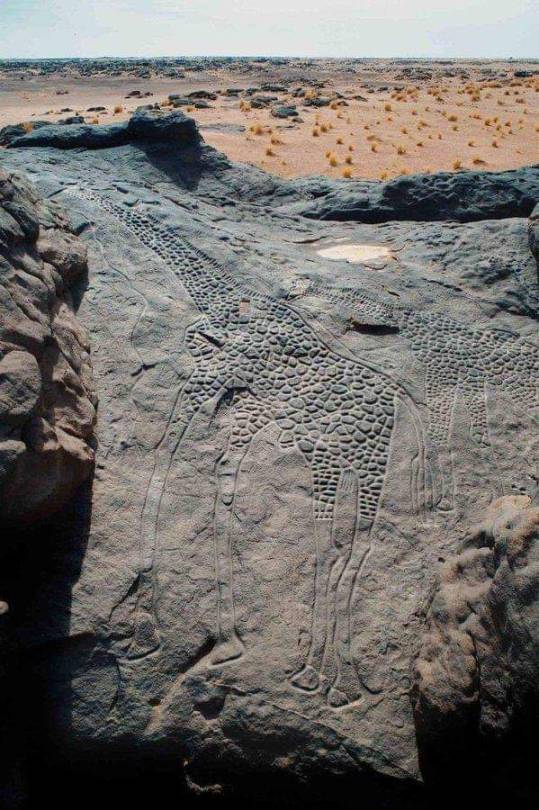
Located in Air Massif, Niger are two of the biggest animal rock petroglyphs in the world, called the Dabous Giraffes, dated 8000 BC.
Credit: @historydefined
3K notes
·
View notes
Photo
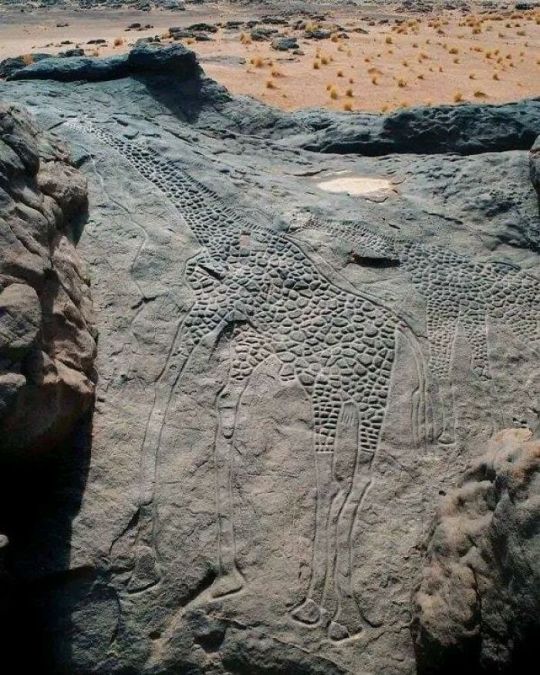
Located In Air Massif, Niger Are Two Of The Biggest Animal Rock Petroglyphs In The World, Called The Dabous Giraffes, Dated 8000 BCE
496 notes
·
View notes
Text

Located in Air Massif, Niger are two of the biggest animal rock petroglyphs in the world, called the Dabous Giraffes, dated 8000 BC.
5 notes
·
View notes
Text
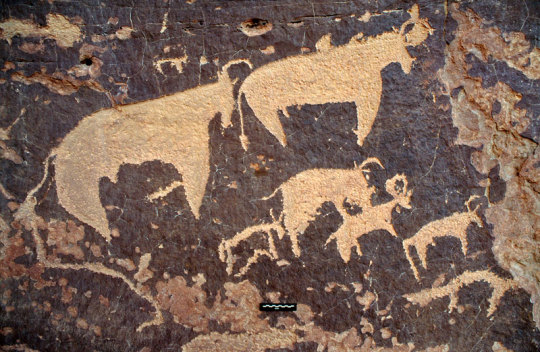
Djaba, Niger. Cattle. The black patina in the shape of the cattle has been scraped off the rock before painting started.
“Africa’s rock art is the common heritage of all Africans, but it is more than that. It is the
common heritage of humanity.”
President Nelson Mandela
Niger is geographically diverse, having both the Sahel (savannah) and the Sahara (desert). The majority of the country’s rock art – made up predominantly of engravings – is located in the northern desert area, in and around the Aïr Mountains, where some of the art is thought to be several thousand years old. The Djado Plateau in the north-east is also rich in art that includes both paintings and engravings. One of the most celebrated sites of rock engraving is at a place called Dabous, to the west of the mountains. Here, two life-size giraffe were carved on the top of an outcrop, and may be up to 6,000 years old. Other notable areas for engravings are Iwellene in the northern Aïr Mountains, where some of the art is thought to be several thousand years old, as well the sites of Tanakom and Tagueit in the south-eastern Aïr Mountains, where engravings are located on the sides of two wadis (dry riverbeds).
10 notes
·
View notes
Note
I saw your post on rhinoceros distribution in the Mediterranean, and wondered If you ever came across any mention of modern northern giraffes in western Asia in historical times? Ive seen it mentioned In a blogpost before without sources but never could find anything reputable and was curious if There was anything reputable.
Sometimes claimed to be the “largest animal rock art” image on the planet, “one of the finest examples of rock art in the world,” is the so-called Dabous giraffe petroglyph. The rock art is located in the Tenere region of the Sahara (within the borders of modern-day Mali). The art is estimated to be between 7,000 and 10,000 years old (5000 BC to 8000 BC range). The artists were either Kiffian or the later Mesolithic culture known as Tenerians. Today, this is Tuareg territory.
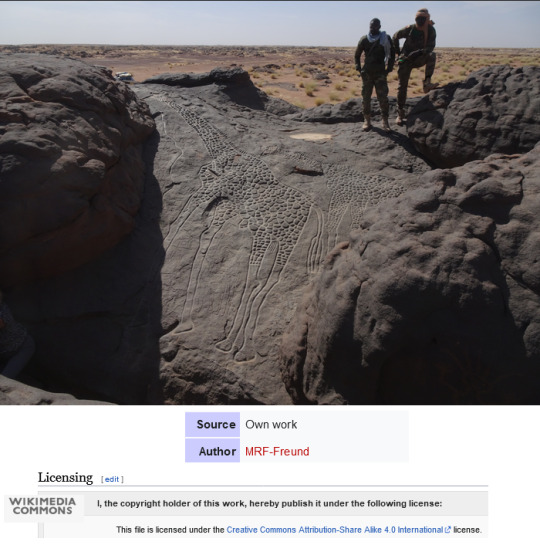
Paleontology, archaeology, taxonomy, etc? Environmental history before the Holocene? Not my specialties. Out of my league.
But I think that we can confidently say that wild giraffes were not present anywhere in Southwest Asia within the past 10,000 years. I, like you, haven't ever yet seen reputable sources for giraffe in the region in this time period. They were in North Africa, though.
We know with certainty about Asian elephants living in Assyria and eastern Anatolia, through physical remains, detailed records, etc. We know with certainty about tigers in Mesopotamia and lions in Persia, because they were still alive less than 100 years ago. Rhinos are conspicuously absent in records of the ancient Fertile Crescent. But at least rhinos existed, independently and separated, in both Africa and South Asia. But giraffes, after the end of the Pleistocene? Not so.
Still, just as we have petroglyphs of rhinos in the Sahara, we also have petroglyphs dating from the Holocene of giraffes in Morocco, Algeria, Libya, and Egypt.
The historical (19th century) and current (2018-ish) distribution range of giraffes:
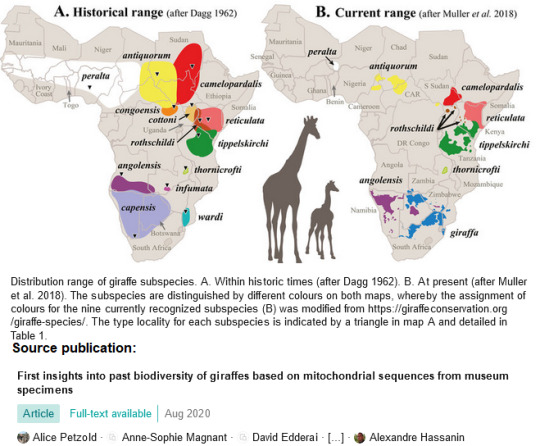
Potential Holocene distribution range of the giraffe within this region:
(1) Giraffe petroglyphs in the Eastern Desert of Upper Egypt suggest that giraffes were present in predynastic times (Holocene, perhaps until 3000 BC, or 5,000 years ago). The Nubian giraffe subspecies may have had continuous range in the Eastern Desert via the Red Sea coastline from the region known to ancient Egyptians as Punt; also in predynastic times, the Nile valley itself, through Nubia, might have been home to giraffes.
(2) Also within the borders of modern-day Egypt, there are more giraffe petroglyphs from the Holocene at the Gilf Kebir wadis; the Gilf Kebir site, like much of the Sahara, would have been much less arid during the Green Sahara climatic period, which appears to have lasted until 4000 BC, suggesting giraffes may have been widespread across the Sahara until that date.
Giraffes may also have lived (3) near the Mediterranean coast by way of the Atlas mountains (in Morocco, Algeria, and Tunisia). This is supported by the existence of giraffe petroglyphs in the Anti-Atlas of southern Morocco. Some distribution maps also suggest giraffes (4) may have lived near the Mediterranean on the Cyrenaican coast of Libya, which could’ve been populated by giraffes via the use of the Tibesti and Ahaggir mountains. But I don’t know where the Cyrenaican giraffe evidence comes from?
What we do know is that the giraffe, during the Holocene, was present in the Tibesti, Ahaggir, Tassili n’Ajjer, Messak, and Gilf Kebir regions of the Sahara in North Africa . Whether this allowed them to maintain populations in the Atlas mountains or Cyrenaica is unknown, despite W!kiedia and hobbyist references to “giraffes in Morocco until 600 AD.”
Giraffe petroglyphs from the Messak region of Libya:
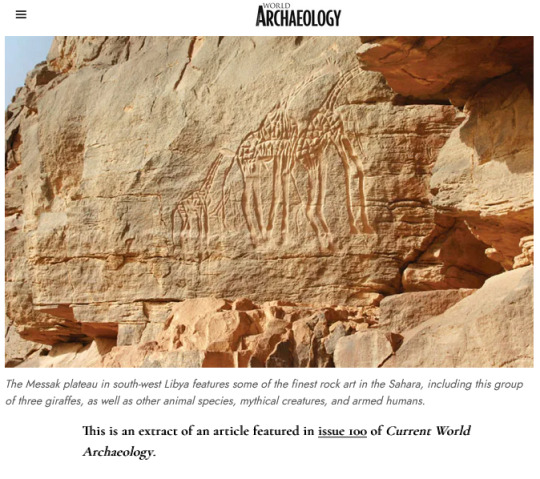
So, again from working-class GIS (MSPaint), my guess at giraffe distribution in the Holocene, using petroglyphs and known environment during the Green Sahara period:
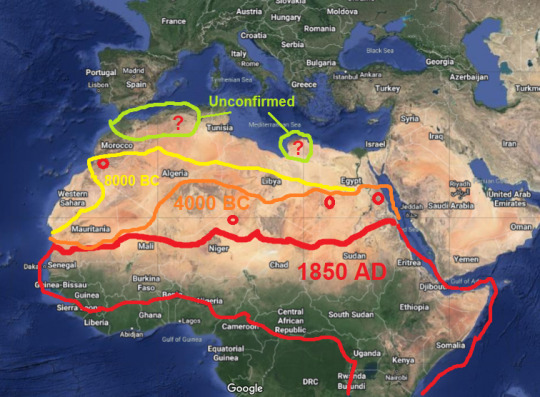
The red circles indicate giraffe petroglyph sites.
---
Quick run-down of what we know:
- I’ve only seen one reliable reference to genuine evidence/physical remains of Giraffa from relatively “recent” Asia: modern/extant Giraffa camelopardalis remains recovered at Latamne in Syria. But the remains seem to be from the Middle Pleistocene, maybe over 250,000 years old, maybe closer to 1 million years in age. (I'm not sure, I don't know anything about this site.)
- There are several large, clear, and/or conspicuous giraffe petroglyphs in the Messak plateau region of modern-day Libya. The Wadi al-Ajal site, in particular, features impressive giraffe art.
- Holocene giraffe remains/petroglyphs have been found at Wadi El Akhdar and Wadi El Bakht in Gilf Kebir of modern-day Egypt.
- Giraffe petroglyphs also exist in the Eastern Desert of Egypt.
- Among 32 panels at the petroglyph site known as Taheouacht-2 in Morocco are the images of two rhinos, and also two giraffes apparently being hunted by human figures.
- The Dabous giraffe petroglyph of the Tenere region (within modern borders of Niger) proves giraffes were known to Kiffians and/or Tenerians in the region as late as 8000 BC to 5000 BC. (The Dabous art is often described as one of the most awe-inspiring, precious, important, etc. pieces of rock art on the planet.)
- There is no doubt whatsoever that Egyptians were very familiar with giraffes. But they appear mostly in the context of tribute or import from Nubia, Kush, Punt, etc.
- I’m pretty sure(?) that giraffes also appear in the rock art of Tassili n’Ajjer in Algeria. At least, elephants and rhinos appear in this art. The petroglyphs may date to as late as 6000 BC or 4000 BC.
- “Giraffe lived in Morocco until 600 AD” is a hard claim to substantiate. Various websites and resources make the claim, and they cite Wikipedia, which itself cites one line in a giraffe book, but the publicly-accessible view of this note/citation doesn’t specify where/how this was determined. (Maybe the book itself contains more/better info on the source of this claim?)
- Giraffa sivalensis is one of the only relatively better-understood extinct early giraffes, since the various others are unclear and taxonomically suspect (Giraffa jumae, stillei, priscilla, gracilis, ppygmaea and punjabiensis). However, Giraffa sivalensis is presumed to have been recovered from the upper Siwalik deposits dated to something like 2.6 to 0.6 million years of age. So??? This is the same region which yielded remains of some Pliocene and Pleistocene creatures like Asiatic ostrich lineages, some mastodons, and Crocodylus palaeindicus. “Giraffes and humans together in Europe!” Big difference between Homo erectus and archaic Giraffa sivalensis one million years ago, and any interaction between humans-with-domesticated crops of the Holocene only within the past 12000 years.
---
Using current taxonomy and current known distribution range, the subspecies present in Nubia/Axum and presumably Egypt/Red Sea would be Giraffa camelopardalis camelopardalis, the “Nubian giraffe.” The subspecies designation of Saharan giraffes might be more unclear, since both West African and Kordofan subspecies currently live nearby,but the West African giraffe known as Giraffa camelopardalis peralta today lives closest to the Dabous petroglyphs, Ahaggir, Tassili n’Ajjer, and Atlas regions.
Regarding the West African subspecies, according to the Giraffe Conservation Foundation, excerpted from their online site: “At the beginning of the 20th century the West African giraffe were widely distributed, from Nigeria to Senegal, but by the mid-1990s only 49 individuals remained in the whole of West Africa. These few survivors are now formally protected by the Niger government and their numbers have risen to more than 600 individuals. However, their future is still of great concern [...]. No other large wild mammals occur in this area [...].” Regarding the Nubian subspecies, also from GCF’s site: “The estimated number of Nubian giraffe is approximately 3,000 individuals, which includes the genetically identical formerly recognised Rothschild’s giraffe. At present, fewer than 175 occur in western Ethiopia, less than 450 in eastern South Sudan, approximately 700 in Kenya, and more than 1,800 in Uganda.”
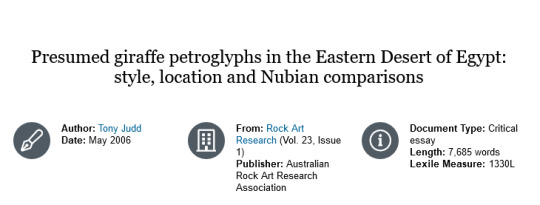
I’d guess that the Nubian giraffe was apparently present northward along the Nile, and eastward toward the Red Sea near the northern border of Eritrea at the historic site of Punt, accounting for the giraffe petroglyphs in the Eastern Desert. Did G.c. camelopardalis live farther north past Nubia into Upper Egypt? Perhaps. But they were probably extinct by the time of Old Kingdom. Other records from the Old Kingdom do describe frequency of encounters with wildlife in Nubia. Even references to elephants in Nubia may actually reflect possible trade or transplant from even farther upriver. Did G.c. camelopardalis live farther north along the Red Sea coastline into the Eastern Desert of Egypt? Maybe. But there aren’t records and the same pressures of the Nile valley of Upper Egypt (human presence, hunting/collection, regional aridification following Green Sahara) were present. So: Probably no giraffes in Egypt proper after Old Kingdom foundation.
The subspecies G.c. peralta (today confined to southern Niger) is the one to watch, I’d say. And like the white rhinoceros (the living Ceratotherium simum and Ceratotherium cottoni), the giraffe is desert-tolerant and local populations can thrive in deserts. Specific populations of African savanna elephant can also thrive in deserts. Using ancient distribution of white rhinos, ancient distribution of elephants, and early Holocene rock art as indicators, I’d guess that, at the time of early dynastic Egypt, the current West/North African subspecies G.c. peralta was present in the Tibesti, Ahaggir, and Tassili n’Ajjer mountains.
It’s possible that they were in the Mediterranean, most likely Atlas Mountians from northern Mauritania, through Morocco and northern Algeria. They also could have been present in Cyrenaica.
But then, if giraffes were present in Cyrenaica, where are the records or literature mentions? Phoenicians, Greeks, some Egyptians, and Romans all settled in Cyrenaica, but the giraffe is mostly only mentioned as a transplant in the Mediterranean, in records about African gifts, menageries, tribute, etc.
Giraffe petroglyphs at Gilf Kebir in modern-day Egypt:
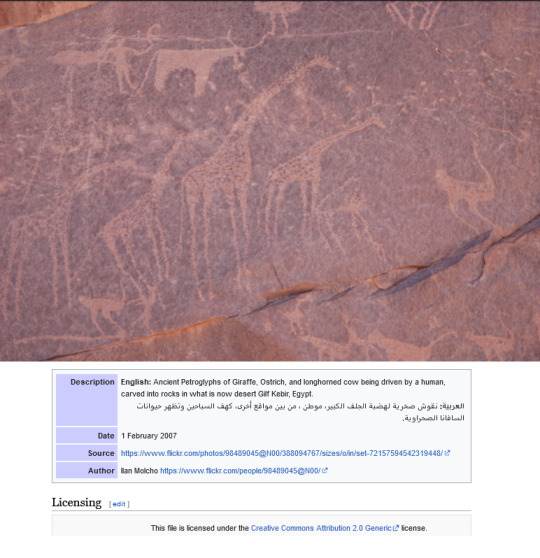
20 notes
·
View notes
Text
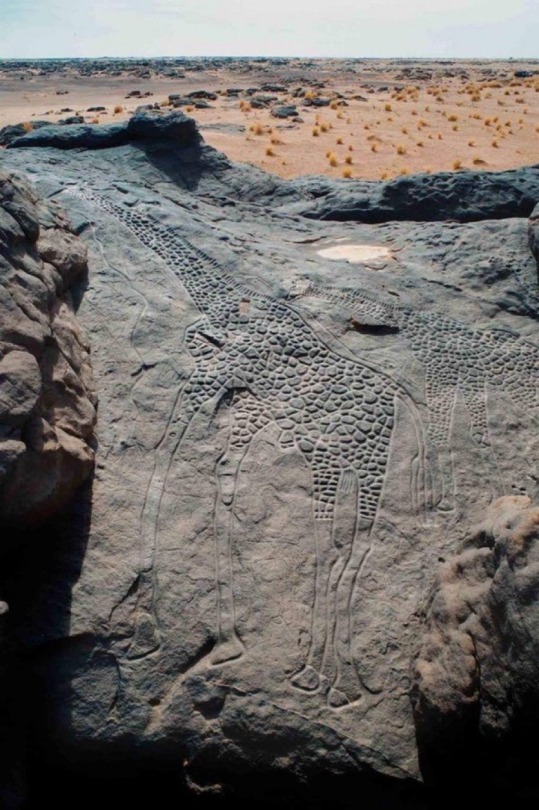
Located in Air Massif, Niger are two of the biggest animal rock petroglyphs in the world, called the Dabous Giraffes, dated 8000 BC
4 notes
·
View notes
Text

You might think this is just a cool rock but no no! This is the Dabous Rock, found among the Air Mountains in West Africa. On this beautiful rock face you can find the largest known neolithic pictographs of animals in the world.
This beautiful display of two giraffes, one male one female, are twenty foot in height and are surrounded by hundreds of other smaller carvings of various animals and humans and may be 8000 years old.
I love these funky giraffes so much. They're a beautiful work of complex art from the time the Sahara desert was still a savannah and a beautiful testament to the skill of the artists who carved them so long ago.
0 notes
Text
Spotlight Art – History – Dabous Giraffes - Petroglyph - Dabous - Agadez - Niger
Dabous Giraffe Petroglyph
The Dabous life-size giraffes dating from c. 5000 – 3000 BCE are found north of Agadez in north-eastern Niger where the Ténéré Desert meets the slopes of the Aïr Mountains. These ancient petroglyphs are some of the most striking examples of Saharan rock art.
It is not known who carved the realistic figures. It is argued that that they may have been carved by the Tuareg…
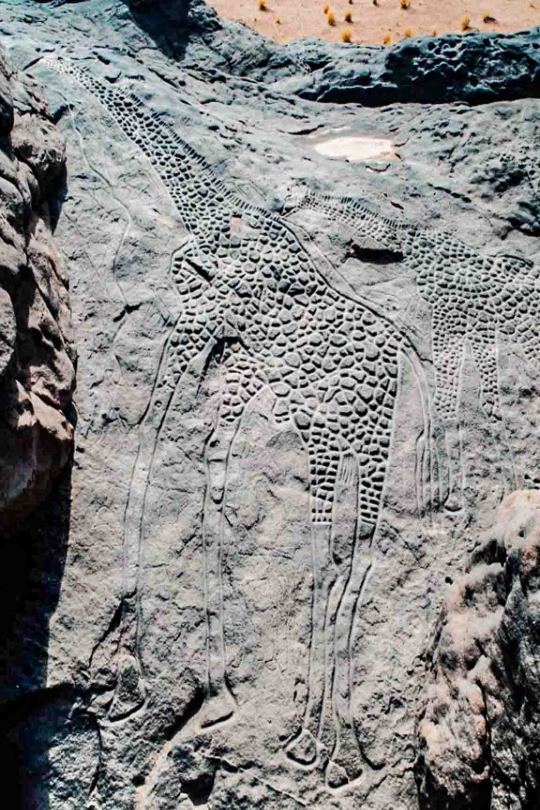
View On WordPress
#Art#Art Music Photography Poetry Quotations#Carving#Giraffe#Goff James#goff james art /music/photography/poetry/quotations#Goff James Art Music Photography Poetry Quotations#goffjamesart#History#Niger#Photography#Poem#Poet#Poetry#Rock Art#Saharan Rock Art#Senryū
1 note
·
View note
Photo
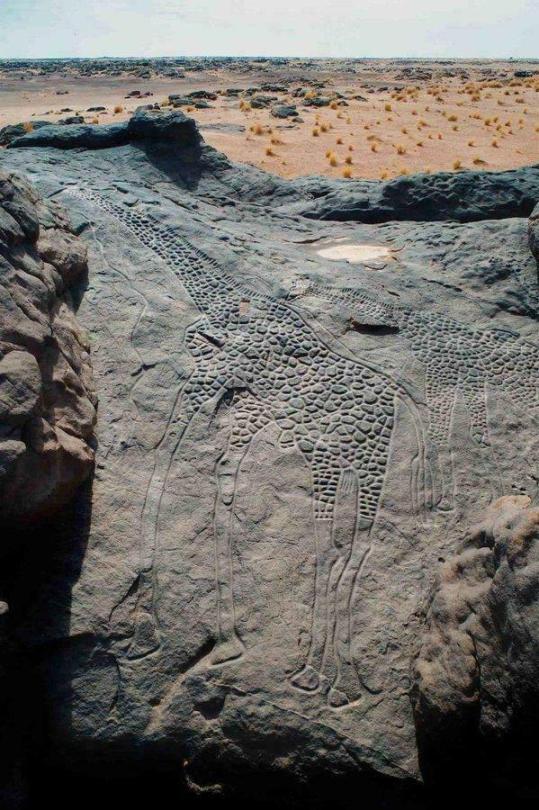
Located in Air Massif, Niger are two of the biggest animal rock petroglyphs in the world, called the Dabous Giraffes, dated 8000 BC.
0 notes
Text
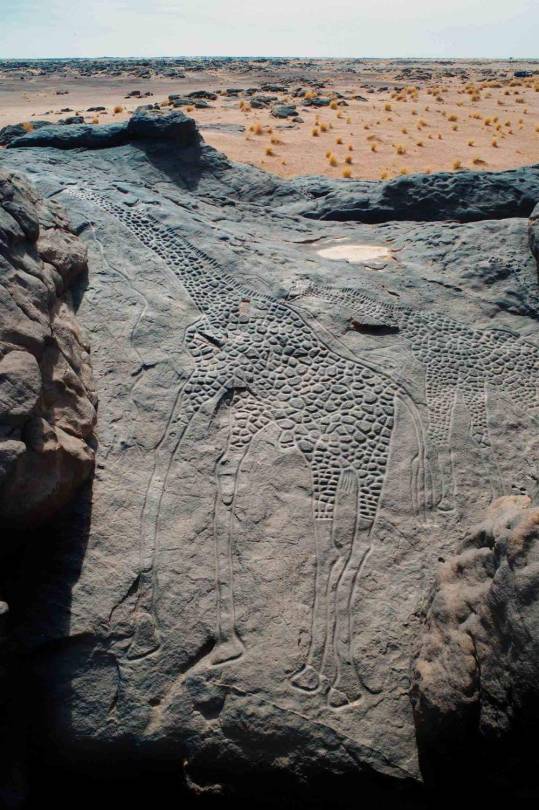
Located in Air Massif, Niger are two of the biggest animal rock petroglyphs in the world, called the Dabous Giraffes, dated 8000 BC.
223 notes
·
View notes